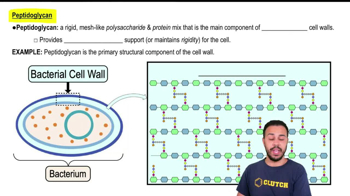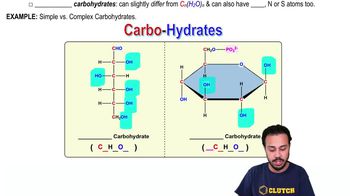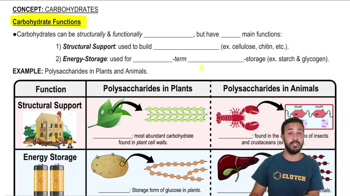Table of contents
- 1. Introduction to Biology2h 42m
- 2. Chemistry3h 40m
- 3. Water1h 26m
- 4. Biomolecules2h 23m
- 5. Cell Components2h 26m
- 6. The Membrane2h 31m
- 7. Energy and Metabolism2h 0m
- 8. Respiration2h 40m
- 9. Photosynthesis2h 49m
- 10. Cell Signaling59m
- 11. Cell Division2h 47m
- 12. Meiosis2h 0m
- 13. Mendelian Genetics4h 44m
- Introduction to Mendel's Experiments7m
- Genotype vs. Phenotype17m
- Punnett Squares13m
- Mendel's Experiments26m
- Mendel's Laws18m
- Monohybrid Crosses19m
- Test Crosses14m
- Dihybrid Crosses20m
- Punnett Square Probability26m
- Incomplete Dominance vs. Codominance20m
- Epistasis7m
- Non-Mendelian Genetics12m
- Pedigrees6m
- Autosomal Inheritance21m
- Sex-Linked Inheritance43m
- X-Inactivation9m
- 14. DNA Synthesis2h 27m
- 15. Gene Expression3h 20m
- 16. Regulation of Expression3h 31m
- Introduction to Regulation of Gene Expression13m
- Prokaryotic Gene Regulation via Operons27m
- The Lac Operon21m
- Glucose's Impact on Lac Operon25m
- The Trp Operon20m
- Review of the Lac Operon & Trp Operon11m
- Introduction to Eukaryotic Gene Regulation9m
- Eukaryotic Chromatin Modifications16m
- Eukaryotic Transcriptional Control22m
- Eukaryotic Post-Transcriptional Regulation28m
- Eukaryotic Post-Translational Regulation13m
- 17. Viruses37m
- 18. Biotechnology2h 58m
- 19. Genomics17m
- 20. Development1h 5m
- 21. Evolution3h 1m
- 22. Evolution of Populations3h 52m
- 23. Speciation1h 37m
- 24. History of Life on Earth2h 6m
- 25. Phylogeny2h 31m
- 26. Prokaryotes4h 59m
- 27. Protists1h 12m
- 28. Plants1h 22m
- 29. Fungi36m
- 30. Overview of Animals34m
- 31. Invertebrates1h 2m
- 32. Vertebrates50m
- 33. Plant Anatomy1h 3m
- 34. Vascular Plant Transport1h 2m
- 35. Soil37m
- 36. Plant Reproduction47m
- 37. Plant Sensation and Response1h 9m
- 38. Animal Form and Function1h 19m
- 39. Digestive System1h 10m
- 40. Circulatory System1h 57m
- 41. Immune System1h 12m
- 42. Osmoregulation and Excretion50m
- 43. Endocrine System1h 4m
- 44. Animal Reproduction1h 2m
- 45. Nervous System1h 55m
- 46. Sensory Systems46m
- 47. Muscle Systems23m
- 48. Ecology3h 11m
- Introduction to Ecology20m
- Biogeography14m
- Earth's Climate Patterns50m
- Introduction to Terrestrial Biomes10m
- Terrestrial Biomes: Near Equator13m
- Terrestrial Biomes: Temperate Regions10m
- Terrestrial Biomes: Northern Regions15m
- Introduction to Aquatic Biomes27m
- Freshwater Aquatic Biomes14m
- Marine Aquatic Biomes13m
- 49. Animal Behavior28m
- 50. Population Ecology3h 41m
- Introduction to Population Ecology28m
- Population Sampling Methods23m
- Life History12m
- Population Demography17m
- Factors Limiting Population Growth14m
- Introduction to Population Growth Models22m
- Linear Population Growth6m
- Exponential Population Growth29m
- Logistic Population Growth32m
- r/K Selection10m
- The Human Population22m
- 51. Community Ecology2h 46m
- Introduction to Community Ecology2m
- Introduction to Community Interactions9m
- Community Interactions: Competition (-/-)38m
- Community Interactions: Exploitation (+/-)23m
- Community Interactions: Mutualism (+/+) & Commensalism (+/0)9m
- Community Structure35m
- Community Dynamics26m
- Geographic Impact on Communities21m
- 52. Ecosystems2h 36m
- 53. Conservation Biology24m
4. Biomolecules
Carbohydrates
Problem 8`
Textbook Question
Lysozyme, an enzyme found in human saliva, tears, and other secretions, catalyzes the hydrolysis of the β-1,4-glycosidic linkages in peptidoglycan. Predict the effect of this enzyme on bacteria and how it may be involved in human health.
 Verified step by step guidance
Verified step by step guidance1
Understand the role of lysozyme: Lysozyme is an enzyme that catalyzes the hydrolysis of β-1,4-glycosidic linkages in peptidoglycan, which is a major component of bacterial cell walls, particularly in Gram-positive bacteria.
Explore the structure of peptidoglycan: Peptidoglycan is a polymer consisting of sugars and amino acids that forms a mesh-like layer outside the plasma membrane of most bacteria, providing structural support and protection.
Analyze the effect of lysozyme on bacteria: By breaking down the β-1,4-glycosidic linkages in peptidoglycan, lysozyme weakens the bacterial cell wall, leading to cell lysis and death, especially in Gram-positive bacteria.
Consider the implications for human health: Lysozyme is part of the innate immune system, providing a first line of defense against bacterial infections by targeting and destroying bacteria before they can cause harm.
Reflect on the broader significance: The presence of lysozyme in human secretions like saliva and tears helps protect against bacterial invasion, contributing to overall health and preventing infections.
 Verified video answer for a similar problem:
Verified video answer for a similar problem:This video solution was recommended by our tutors as helpful for the problem above
Video duration:
2mPlay a video:
Was this helpful?
Key Concepts
Here are the essential concepts you must grasp in order to answer the question correctly.
Lysozyme Function
Lysozyme is an enzyme that catalyzes the hydrolysis of β-1,4-glycosidic linkages in peptidoglycan, a major component of bacterial cell walls. By breaking these bonds, lysozyme weakens the structural integrity of the bacterial cell wall, leading to cell lysis and death, particularly in Gram-positive bacteria.
Recommended video:
Guided course

Functional Groups
Peptidoglycan Structure
Peptidoglycan is a polymer consisting of sugars and amino acids that forms a mesh-like layer outside the plasma membrane of most bacteria, providing structural support and shape. The β-1,4-glycosidic linkages connect N-acetylglucosamine and N-acetylmuramic acid, which are targeted by lysozyme, compromising the cell wall's strength.
Recommended video:
Guided course

Peptidoglycan
Role in Human Health
Lysozyme plays a crucial role in human health by serving as a natural defense mechanism against bacterial infections. Found in secretions like saliva and tears, it helps protect mucosal surfaces by breaking down bacterial cell walls, thus preventing the colonization and spread of potentially harmful bacteria.
Recommended video:
Guided course

The Human Population
Related Videos
Related Practice
















